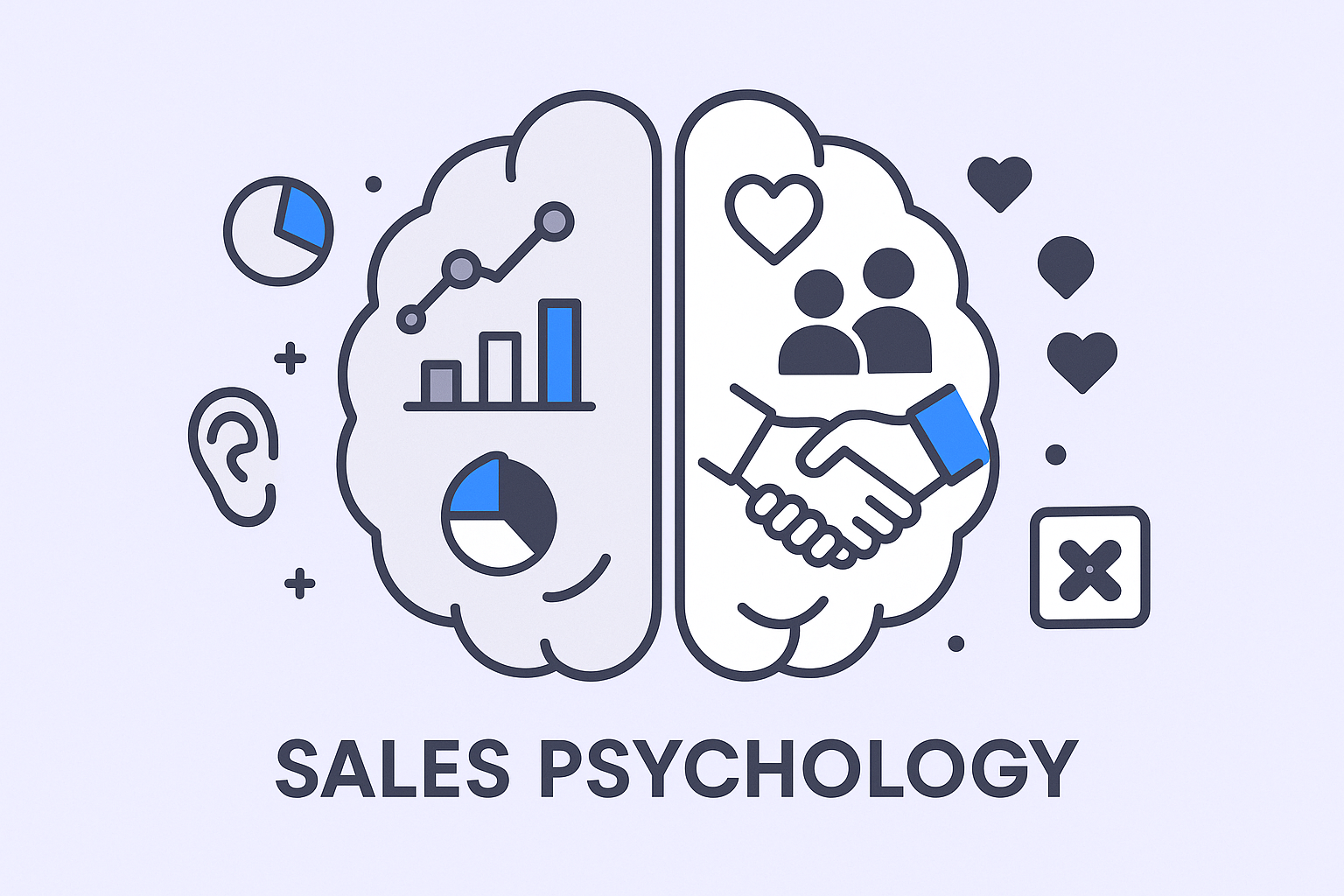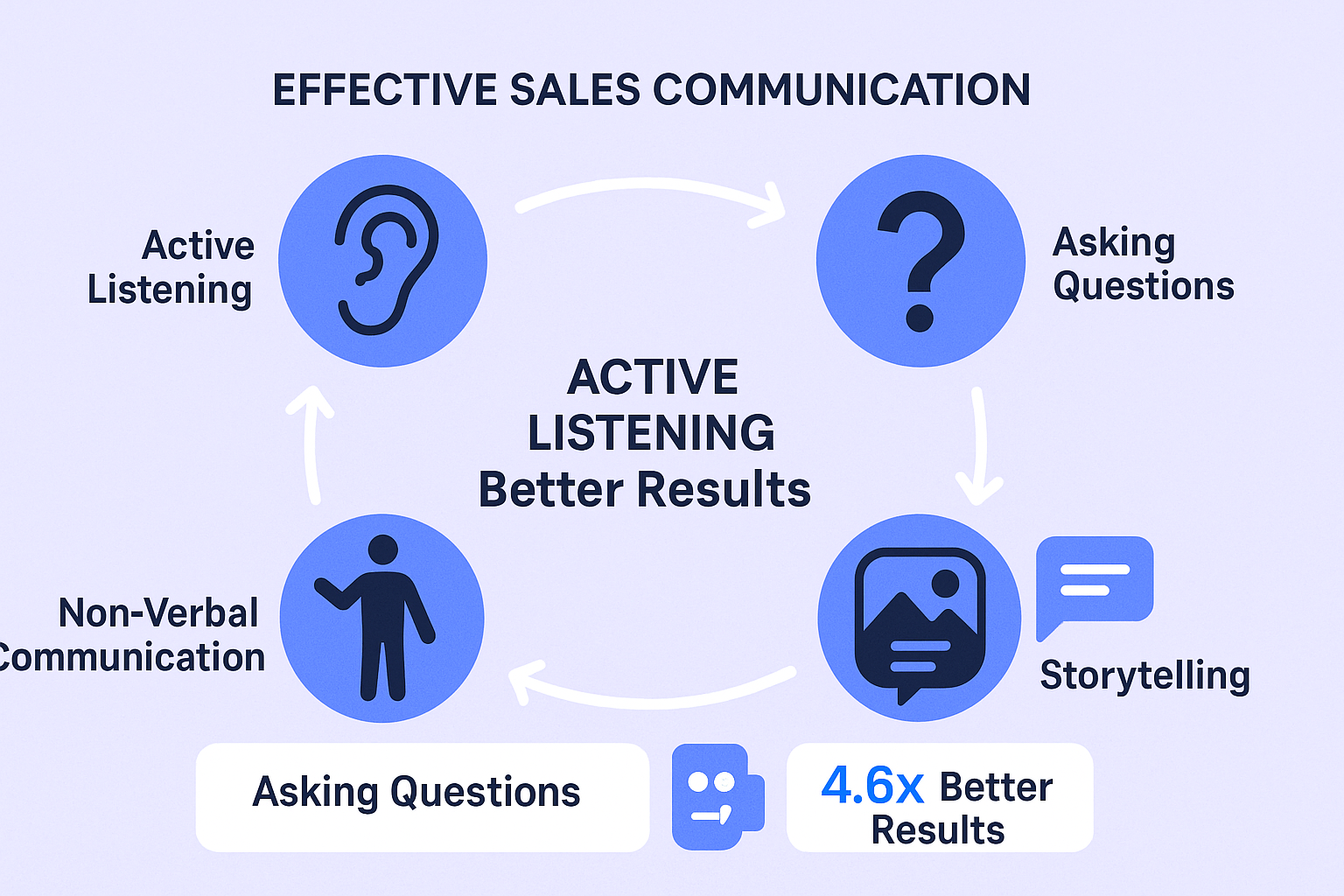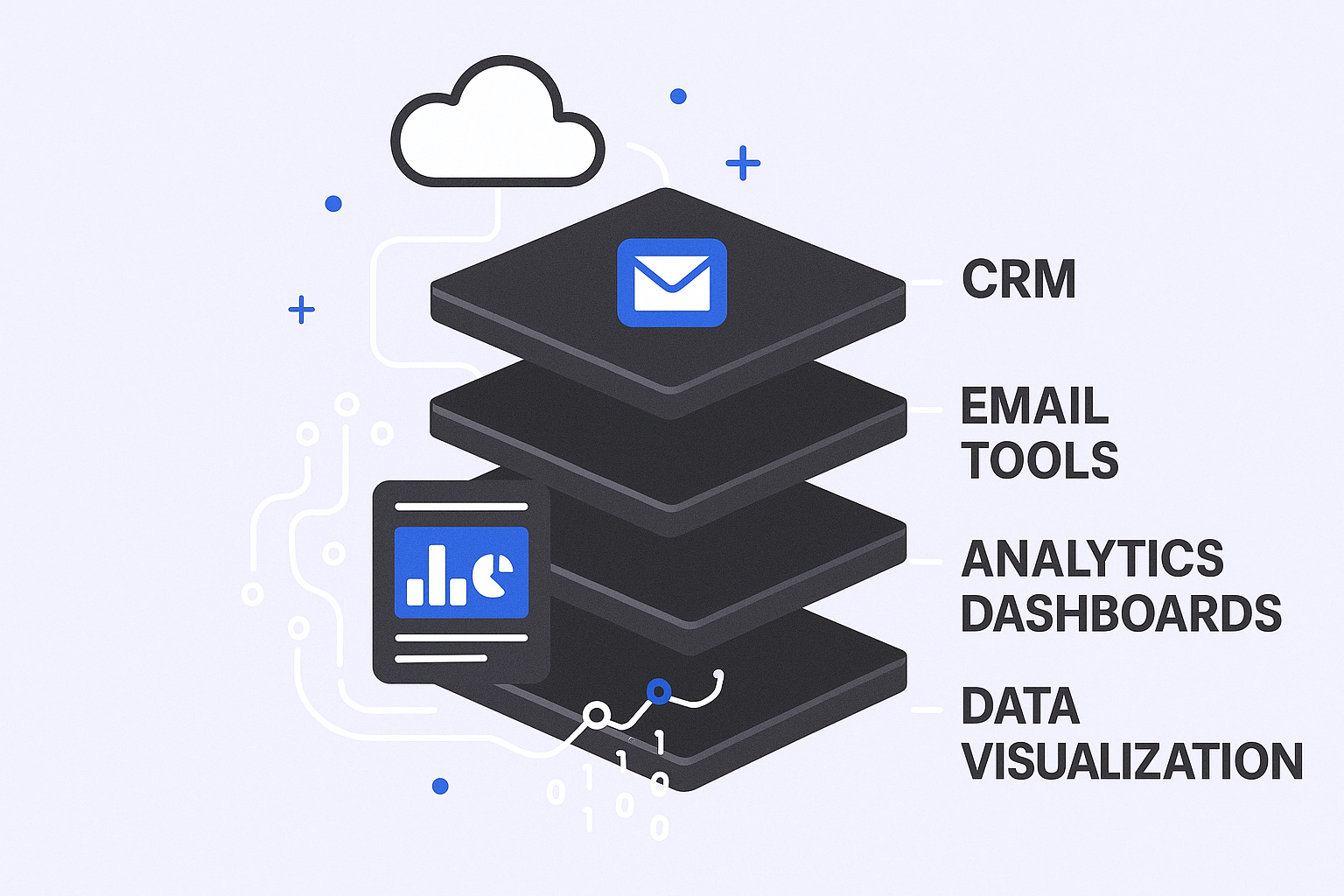- blog
- Lead Generation
- Sales Techniques: Complete Guide to Close More Deals | Salesso

Mastering Sales Techniques: Your Complete Guide to Closing More Deals
Table of Contents
Ever feel like you’re spinning your wheels in sales, putting in the work but not seeing the results you want? You’re not alone. The difference between top performers and everyone else isn’t luck or natural talent—it’s mastering the right sales techniques. Whether you’re making cold calls, nurturing warm leads, or trying to close deals, this guide breaks down the proven strategies that consistently drive results.
The modern sales landscape is more competitive than ever, but here’s the good news: the fundamentals that drive success are learnable, measurable, and repeatable. Let’s dive into the psychology, communication strategies, and technology that will transform your sales performance.
The Psychology Of Sales
Understanding what drives buying decisions is the foundation of every successful sale. It’s not about manipulation—it’s about genuinely connecting with your prospects and helping them solve real problems.
Understanding Your Audience
Before you even think about pitching, you need to know who you’re talking to. This goes way beyond basic demographics. 71% of companies who exceeded their revenue and lead goals have documented buyer personas, according to Cintell research. This isn’t just a marketing exercise—it’s fundamental to sales success.
Understanding your audience means diving deep into their daily challenges, goals, and decision-making processes. What keeps them up at night? What metrics do they care about? Who else influences their buying decisions? When you can answer these questions, your outreach becomes laser-focused and relevant.
The payoff is immediate. When you truly understand your prospects, your emails get opened, your calls get answered, and your meetings feel less like pitches and more like consultations. You’re not just another vendor—you’re someone who gets their world.
Creating A Sense Of Urgency
Urgency isn’t about high-pressure tactics. It’s about helping indecisive buyers act when the timing genuinely makes sense. 69% of millennials experience FOMO, and 60% make impulsive purchases because of it, making urgency a powerful psychological trigger when used ethically.
Effective urgency comes from real scarcity or deadlines—limited beta access, end-of-quarter pricing, or capacity constraints. The key is authenticity. False urgency destroys trust faster than almost anything else in sales.
Smart urgency leverages phrases like “limited availability,” “special pricing through Friday,” or “only accepting 10 new clients this quarter.” But here’s the crucial part: it has to be true. Your prospects are smart, and they can smell fake urgency from miles away.
Highlighting Benefits Over Features
Here’s a sobering stat: 82% of buyers felt overwhelmed by the amount of information in the sales process. Even worse, only 17% of sellers are viewed as trusted advisors by buyers. Why? Because most salespeople dump features instead of focusing on outcomes.
Features tell. Benefits sell. Your prospects don’t care about your software’s advanced algorithms—they care about saving 3 hours per week. They don’t want to hear about your 99.9% uptime—they want to know their customers will never experience frustrating downtime.
The shift from features to benefits transforms sales conversations from product demos into problem-solving sessions. When you focus on outcomes, you’re speaking the language your prospects actually care about.
Building Rapport With Customers
People buy from people they know, like, and trust. Building rapport isn’t about fake small talk—it’s about genuine human connection. Research shows that authentic rapport-building techniques like active listening, maintaining genuine eye contact, and demonstrating real empathy significantly impact sales outcomes.
The “FORD method” (Family, Occupation, Recreation, Dreams) helps you remember personal details about prospects. When you reference something from a previous conversation—their kid’s soccer tournament or their company’s recent expansion—you show you’re paying attention and you care.
But here’s the key: it has to be genuine. Forced rapport feels slimy and actually hurts your chances. Focus on being authentically interested in your prospects as people, not just potential commissions.
Effective Communication Sales Techniques
Communication is where sales are won or lost. It’s not just what you say—it’s how you listen, how you ask questions, and how you make your prospects feel heard and understood.
Active Listening
Here’s a game-changing statistic: prospects should ideally speak 57% of the time in sales calls, but they often only get 25% of the talking time. This massive gap represents a huge opportunity for salespeople who master active listening.
Active listening means more than waiting for your turn to talk. It means processing what your prospect is really saying, asking follow-up questions, and adapting your response to show you truly understand their situation.
When you master active listening, magic happens. Your prospects feel heard. They open up about their real challenges. They start seeing you as a consultant, not a vendor. The conversation becomes collaborative instead of adversarial.
Asking Open-ended Questions
Open-ended questions are your secret weapon for uncovering real needs and building trust. Questions starting with “why,” “what,” and “how” get prospects thinking out loud and revealing their pain points, fears, and desires.
Effective questioning follows a progression:
- Level One: Building rapport (“How did you get started in this industry?”)
- Level Two: Understanding challenges (“What’s the biggest obstacle you’re facing with your current solution?”)
- Level Three: Exploring implications (“How is this affecting your team’s productivity?”)
- Level Four: Moving toward solutions (“What would an ideal solution look like for you?”)
Each level deepens the conversation and builds trust while giving you the insights you need to position your solution effectively.
Using Persuasive Language
Top salespeople use language strategically. Research shows that successful sellers adjust their language based on the situation. Early in conversations, using “we” language builds company credibility: “We’ve helped similar companies reduce costs by 30%.”
During negotiations, shifting to “I” language humanizes the interaction: “I’d like to find a solution that works for both of us.” This subtle shift helps prospects see you as a person, not just a company representative.
The key is authenticity. These aren’t manipulation tactics—they’re communication strategies that help build genuine connections and trust.
Implementing Non-verbal Communication
Your body language speaks before you do. Even on phone calls, your posture and facial expressions affect your voice tone and energy. Non-verbal communication can make or break rapport, even in digital interactions.
Key elements include maintaining appropriate eye contact, using open gestures, and matching your prospect’s energy level. When presenting virtually, look at your camera, not your screen, to maintain “eye contact.” Use hand gestures to emphasize points, even if you’re not on video—it affects your vocal energy.
Mastering non-verbal communication helps you appear more confident, trustworthy, and engaging, which directly impacts your ability to close deals.
Refining Your Pitch And Presentation
A compelling pitch isn’t about perfect slides or memorized scripts. It’s about connecting with your audience and clearly demonstrating value in a way that resonates with their specific situation.
Crafting A Compelling Message
Your message needs to cut through noise and clearly communicate why prospects should choose you over alternatives. A compelling message focuses on your unique value proposition and explains how you solve problems or create opportunities for your specific audience.
The most effective messages include clear timelines, specific benefits, and compelling reasons to act. Instead of generic value props like “increase efficiency,” use specific outcomes like “reduce manual data entry by 15 hours per week.”
Beyond Traditional Sales Techniques
LinkedIn outbound engine applies proven psychology and personalization at scale
Using Storytelling Techniques
Stories grab attention, help people visualize solutions, and create emotional connections. A well-timed story can help prospects see exactly how your solution will impact their world.
Effective sales stories follow a simple structure: a relatable hero faces a challenge (similar to your prospect’s situation), tries various solutions, and ultimately succeeds with your help. The key is making the story relevant and the outcome tangible.
Keep stories brief—under two minutes—and always tie them back to your prospect’s specific situation. The goal isn’t entertainment; it’s helping your prospect visualize their own success.
Incorporating Visuals And Multimedia
Visuals dramatically improve comprehension and retention. 100% of people believe a slide should include visuals, and people remember just 10% of what they hear but up to 65% when visuals are added.
For B2B sales, data visualization is particularly powerful. Charts and graphs help decision-makers quickly grasp complex information and see the business case for your solution. 65% of people are visual learners, making well-designed visuals essential for effective presentations.
Use minimal text on slides—no more than one-fourth of the slide should be text. Let your visuals tell the story while you provide the commentary.
Keeping It Simple
Clarity beats cleverness every time. Your pitch should include a clear introduction, compelling value proposition, social proof, and obvious next steps. Even the most innovative solution won’t sell if prospects can’t understand it.
Focus on your Unique Selling Proposition (USP) and the specific problems it solves. If you’re the only plug-and-play solution in your category, emphasize how this eliminates implementation headaches. Make your differentiation crystal clear.
Simple, clear pitches reduce decision paralysis and help close deals faster by making the value proposition easy to understand and act on.
Overcoming Objections
Objections aren’t roadblocks—they’re opportunities to understand concerns and build trust. The key is preparation, listening, and reframing challenges as solvable problems.
Identifying Objections Before They Arise
The best objection handling happens before objections surface. Through thorough research and strategic questioning, you can anticipate common concerns and address them proactively in your presentation.
Study your competition and understand their typical messaging. If competitors claim you’re too expensive, be ready to demonstrate ROI. If they say you’re too complex, have simple implementation stories ready. Proactive objection handling builds confidence and reduces friction.
Ask intentional, open-ended questions during discovery to uncover potential concerns early. “What’s worked well with your current solution?” and “What would prevent you from making a change?” help identify objections while they’re still manageable.
Listening And Acknowledging
When objections do arise, your first response should be to listen completely and acknowledge what you’ve heard. Paraphrase their concern back to them to ensure understanding: “So if I understand correctly, you’re concerned about the implementation timeline?”
This simple acknowledgment shows you’re listening and creates space for productive dialogue. Never dismiss or minimize objections—even if you’ve heard them a thousand times, they’re new and important to this prospect.
Validation builds trust: “I completely understand that concern. Implementation timeline is crucial for a project like this.” This approach shifts the dynamic from adversarial to collaborative.
Reframing Objections
After acknowledging objections, reframe them from a different perspective using the “Address, Reframe, Redirect” technique. Acknowledge the concern, offer a new way to look at it, then redirect to your strengths.
For example, if a prospect says they’re doing fine with their current solution, you might respond: “I’m glad to hear things are going well. Many of our best clients were in similar positions—they were doing fine but wanted to take their results to the next level. That’s exactly where we’ve seen the biggest impact.”
Reframing requires finesse and authenticity. The goal isn’t to argue but to offer a fresh perspective that opens possibilities.
Using Social Proof
Social proof dramatically influences decisions and reduces perceived risk. Consumer reviews are trusted nearly 12 times more than manufacturer descriptions, making testimonials and case studies incredibly powerful.
Share specific examples of how similar companies solved the same challenges your prospect faces. Use metrics when possible: “Another manufacturing company reduced their processing time by 40% in the first month.”
Expert endorsements, industry awards, and customer testimonials all serve as powerful social proof that reduces buyer hesitation and builds confidence in your solution.
Effective Negotiation Strategies
Negotiation isn’t about winning—it’s about finding solutions that work for everyone. The best negotiations result in stronger relationships and better long-term outcomes.
Setting Clear Expectations
Successful negotiations start with clear objectives and thorough preparation. Define your desired outcomes, understand the other party’s likely priorities, and identify potential trade-offs before the conversation begins.
Research market conditions, understand industry benchmarks, and know your alternatives. This preparation gives you confidence and helps you identify creative solutions that might not be obvious in the moment.
Clear objectives also help you evaluate proposals objectively and avoid getting caught up in the emotions of the moment.
Identifying And Addressing Objections
In negotiations, focus on understanding underlying interests rather than just stated positions. Positions are what people say they want; interests are why they want it.
Use active listening and open-ended questions to uncover these deeper motivations. “Help me understand what’s driving that requirement” often reveals flexibility that wasn’t apparent in initial positions.
When you understand the “why” behind requests, you can often find creative alternatives that satisfy the underlying need without compromising your own objectives.
Finding Win-win Solutions
The best negotiations result in win-win outcomes where both parties feel they’ve gained value. This approach builds stronger long-term relationships and creates more sustainable agreements.
Brainstorm multiple options that could address both parties’ interests. Often, the first solution that comes to mind isn’t the best one. Creative problem-solving during negotiation often uncovers value that benefits everyone.
Focus on expanding the pie before dividing it. Look for ways to create additional value rather than just splitting existing value.
Offering Incentives
Strategic incentives can accelerate decisions and close deals. However, only 21% of companies demonstrate sales incentive plan effectiveness, meaning most incentive strategies fail to drive the right behaviors.
Effective incentives create genuine value for the buyer while motivating action. This might include extended warranties, additional training, or flexible payment terms that ease budget constraints.
The key is ensuring incentives align with buyer needs rather than just pushing for closure. Incentives should feel like value-adds, not desperate discounts.
Leveraging Technology For Sales Success
Technology isn’t just nice-to-have anymore—it’s essential for competing effectively and scaling your efforts efficiently.
Utilizing CRM Software
CRM systems deliver an average ROI of $8.71 for every dollar spent and can shorten sales cycles by 8 to 14%. 91% of US businesses with more than 10 employees use CRM systems, making them standard practice for good reason.
Beyond organizing contact information, modern CRMs provide insights into customer behavior, track sales performance, and automate routine tasks. This technology enables personalized interactions at scale and helps identify the highest-value opportunities.
CRM systems also improve customer retention. Increasing customer retention by just 5% can increase sales between 25% and 95%, making customer relationship management crucial for long-term success.
Adopting Digital Sales Tools
Digital sales tools, particularly for email outreach, are essential for scaling personalized communication. 38% of people prefer email contact from companies, and personalized emails can boost sales by up to 20%.
Cold emails with personalized subject lines are 26% more likely to be opened, making personalization crucial for cutting through inbox noise. The cold email software market is projected to reach $2.25 billion by 2033, reflecting growing reliance on these tools.
⚡ Scale Your Sales Outreach
Strategic LinkedIn targeting, proven campaign design, and systematic scaling methods
Book Strategy Meeting
Leveraging Data Analytics
Sales data analysis provides insights for strategy optimization and performance improvement. By tracking key metrics like conversion rates, deal velocity, and win rates, you can identify what’s working and what needs adjustment.
Monitor both activity metrics (calls made, emails sent) and outcome metrics (meetings booked, deals closed) to get a complete picture of performance. The key is consistent tracking and regular analysis to spot trends and opportunities.
Data analytics transforms gut feelings into actionable insights, allowing you to adapt, survive, thrive in competitive markets by making informed decisions based on real performance data.
Developing A Strong Follow-up Strategy
Persistence and value are the keys to effective follow-up. It’s not about being annoying—it’s about staying helpful and relevant throughout the buying process.
Sending Personalized Messages
Personalized follow-up messages significantly improve engagement and conversion rates. Personalized emails are 26% more likely to be opened and can increase revenue by up to 5.7 times.
Reference previous conversations, add personal details from your research, and tailor your message to their specific situation. “I noticed your company just announced expansion into new markets—here’s how similar companies have handled the operational challenges” feels relevant and valuable.
The goal is making each interaction feel custom-crafted rather than mass-produced. This approach builds relationships and keeps you top-of-mind when buying decisions are made.
Timing Follow-ups Appropriately
Timing can make or break your follow-up strategy. 35-50% of sales go to the vendor that responds first, but 80% of sales require five to twelve follow-ups while 92% of reps quit after four attempts.
The opportunity is massive for those who persist strategically. Respond within one hour of initial interest to increase contact rates by 30% and sales conversations by 14.5%. Morning outreach (8-10 AM) often works best for reaching decision-makers.
Multi-touchpoint strategies result in 28% higher qualification rates, proving that consistent, strategic follow-up pays off.
Providing Value In Every Interaction
Every follow-up should provide value, not just request attention. Share relevant industry insights, helpful resources, or solutions to problems they’ve mentioned. This “Always Be Helping” approach positions you as a trusted advisor rather than a persistent vendor.
After demos or meetings, recap key points and offer additional resources. If they mentioned specific challenges, send case studies showing how others solved similar problems. Value-driven follow-ups keep prospects engaged without feeling pressured.
Asking For Feedback
Actively seeking feedback demonstrates customer focus and provides valuable insights for improvement. Use email surveys, social media polls, or direct questions to understand their experience and concerns.
“What questions do you still have about our solution?” or “What would make this decision easier for you?” often uncover obstacles that you can address proactively.
Feedback requests show you care about their experience and are committed to finding the right solution, building trust and improving your approach for future prospects.
Building Trust And Credibility
Trust is the foundation of sustainable sales success. Without it, even the best techniques fall flat. With it, complex deals become straightforward conversations.
Establishing Authority
Become a genuine expert in your industry by staying current on trends, sharing insights, and solving problems for your market. Speak at industry events, write helpful content, and participate actively in professional communities.
Authority isn’t about being the smartest person in the room—it’s about being genuinely helpful and knowledgeable. When prospects see you as a trusted resource, they’re more likely to engage openly and seriously consider your solutions.
Providing Social Proof
Showcase testimonials, case studies, and customer success stories that demonstrate real results. Consumer reviews are trusted nearly 12 times more than manufacturer descriptions, making social proof incredibly powerful for building confidence.
Share specific examples with measurable outcomes: “Similar companies typically see 30% improvement in productivity within 60 days.” Specific, relevant social proof reduces perceived risk and accelerates decision-making.
Being Transparent And Honest
Transparency builds trust faster than any sales technique. Admit limitations where appropriate, provide accurate timelines, and set realistic expectations. Prospects appreciate honesty and are more likely to trust transparent communicators.
Address concerns directly rather than deflecting. If your solution isn’t perfect for their situation, say so. This honesty often leads to referrals and builds long-term credibility in your market.
Providing Excellent Customer Service
Exceptional service builds loyalty and drives referrals. Loyal customers are six times more likely to forgive mistakes and twice as likely to recommend your business. Increasing customer retention by just 5% can increase sales between 25% and 95%.
Excellent service starts during the sales process and continues long after the deal is closed. Responsive communication, proactive problem-solving, and genuine care for customer success create advocates who drive future growth.
Sales Team Management
Building and managing high-performing sales teams requires strategic hiring, continuous development, clear expectations, and consistent measurement.
Hiring The Right People
Use technology and data-driven approaches to identify top talent. Embrace AI-powered recruiting tools and focus on diversity to bring varied perspectives and stronger problem-solving capabilities to your team.
Look for specific skills like customer focus, stress resistance, and adaptability. Cultural fit and growth potential often matter more than experience alone. Prioritize candidates who align with your company’s mission and values.
Providing Ongoing Training And Support
Companies investing in sales training are 57% more effective than competitors, with an average ROI of 353%. However, 70% of salespeople lack formal training, and 84% of training is forgotten within three months.
Implement continuous training and coaching programs with regular reinforcement. Companies providing deal-specific coaching see win-rate increases of over 27%. Continuous training results in 50% higher net sales per rep.
Setting Clear Goals And Expectations
Define specific, measurable objectives for your team. Whether it’s revenue targets, activity levels, or customer retention goals, clarity drives performance and accountability.
Use metrics like quota attainment, deal profitability, and customer acquisition to track progress. Well-defined goals provide direction and enable effective performance management.
Measuring And Tracking Progress
Consistent measurement enables optimization and accountability. Track both activity metrics (calls, emails, meetings) and outcome metrics (conversion rates, deal size, win rates).
Monitor lead response times, pipeline velocity, and forecast accuracy to identify improvement opportunities. Regular tracking allows for timely adjustments and continuous optimization of your sales process.
🚀Outbound Strategy That Works
Complete LinkedIn framework combines best sales techniques with modern targeting precision
7-day Free Trial |No Credit Card Needed.
Conclusion
Mastering sales techniques is about combining psychology, communication, technology, and persistence into a systematic approach that consistently delivers results. The most successful salespeople understand that selling is ultimately about helping people solve problems and achieve their goals.
The data consistently shows that relationship-focused, value-driven approaches outperform pushy, feature-heavy tactics. Whether you’re making cold calls, nurturing warm prospects, or negotiating final terms, success comes from understanding your audience, communicating clearly, and maintaining focus on outcomes rather than activities.
Technology amplifies these fundamentals but doesn’t replace them. Use outreach tools for sales to scale your efforts, leverage CRM systems to track relationships, and apply data analytics to optimize performance. But remember that at its core, sales is still a human business built on trust, value, and genuine problem-solving.
The ability to adapt, survive, thrive in competitive markets comes from mastering these fundamentals while staying current with evolving tools and techniques. Focus on continuous improvement, ethical practices, and delivering genuine value at every stage of your sales process. When you achieve business objectives by helping others achieve theirs, success becomes sustainable and scalable.
FAQs
What are the most effective techniques for mastering LinkedIn outbound sales?
How can I become more skilled in objection handling?
What is "social selling" and how does it work?
What are some tips for closing deals successfully?

Master LinkedIn Outbound Techniques
Complete targeting strategy, campaign frameworks, and scaling methods for consistent results
